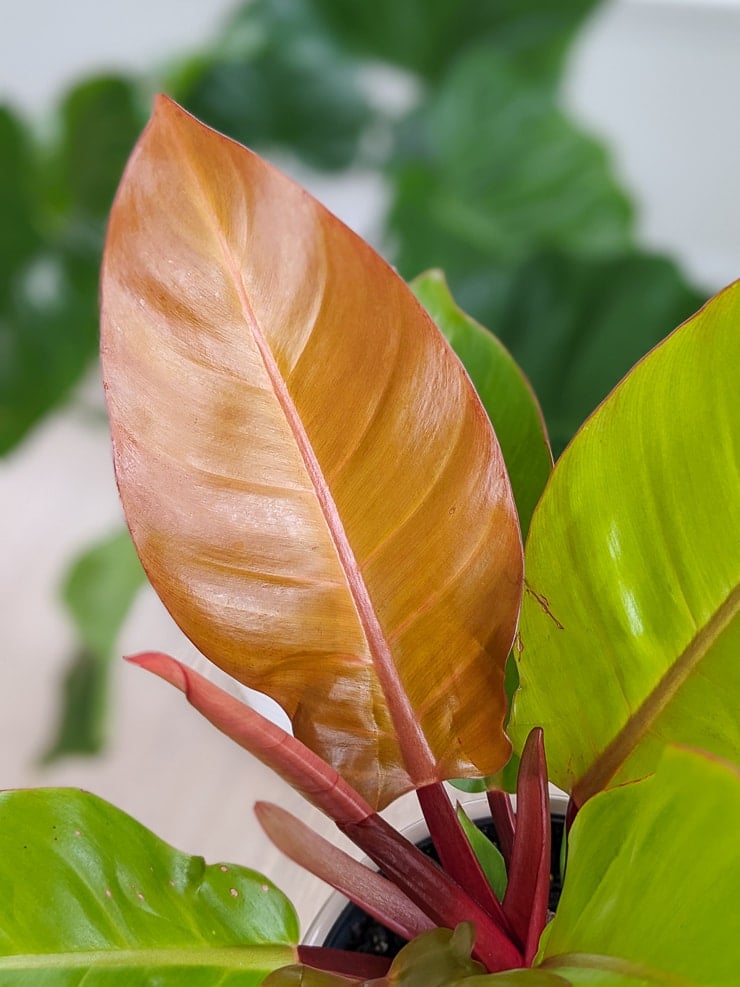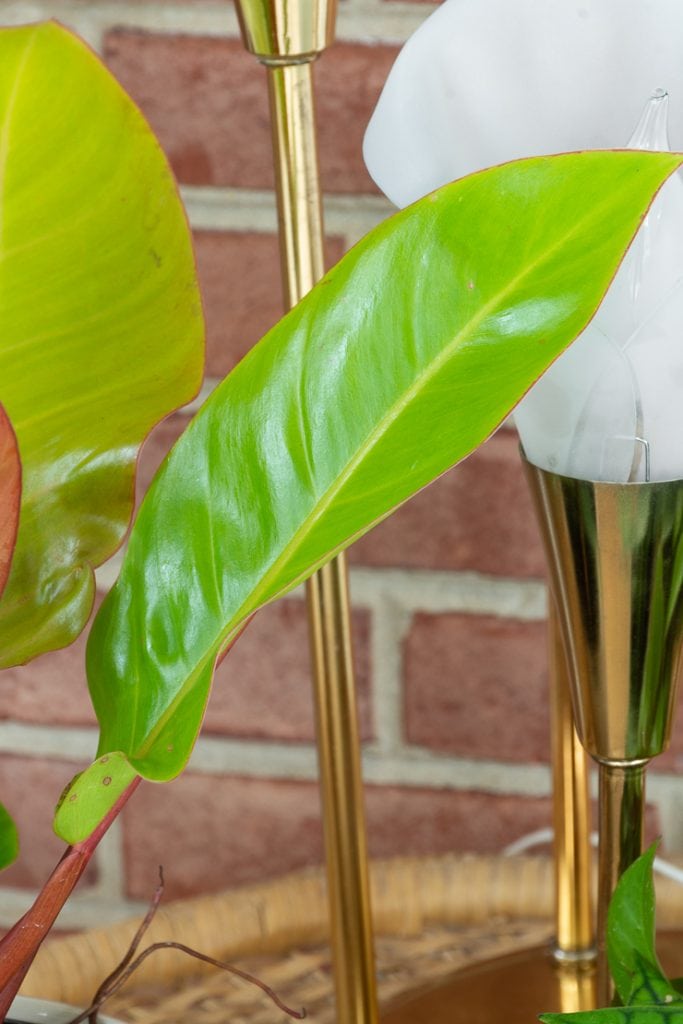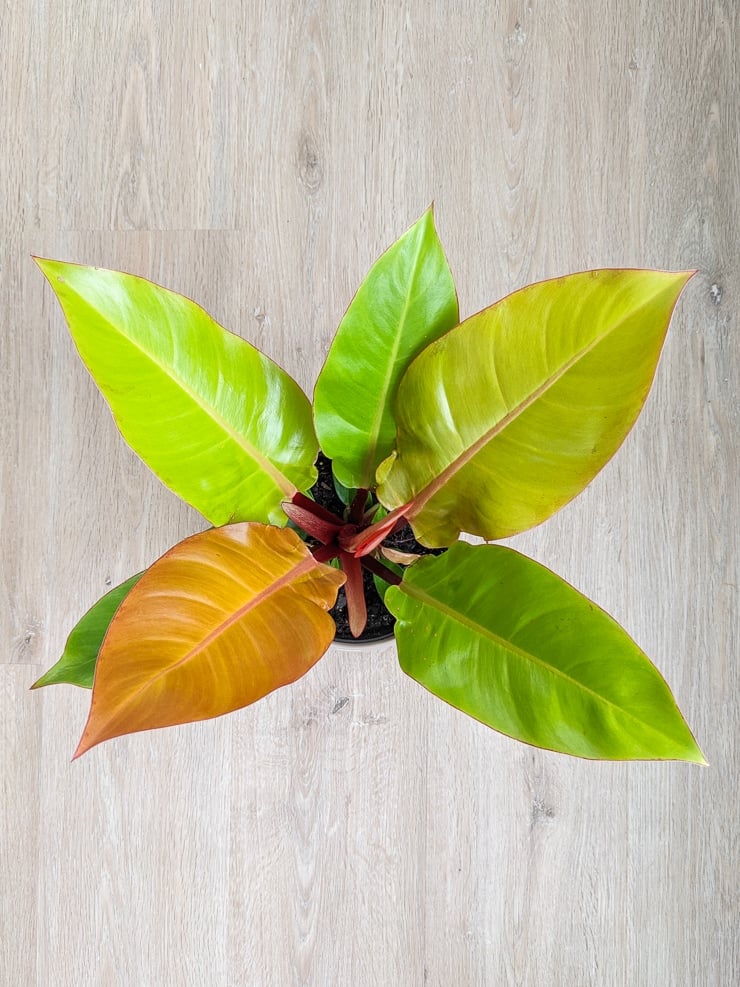The philodendron prince of orange is a brightly-colored tropical that makes an ideal houseplant. Learn more about caring for this cool variety with my guide.
How do you take care of a philodendron prince of orange?
Hey everyone, I have another stunning philodendron for you—the incredible philodendron prince of orange! I’ve seen this fun variety popping up in nurseries for a few years now and couldn’t wait to tell you all more about them.
This is a hybrid variety that was bred from the popular philodendron erubescens, so its full name is philodendron erubescens “Prince of Orange.” This makes it closely related to other erubescens cultivars like the pink princess philodendron and the philodendron rojo congo.

What does a philodendron prince of orange look like?
Philodendron prince of orange has oval-shaped copper or yellow leaves that turn a stunning deep green once they fully mature. The leaves are glossy and may contain white markings throughout.
While the matured green leaves are beautiful, they don’t compare to the brightly colored juveniles, which burst in red, yellow, and copper shades. The colors make a really nice contrast in a sea of otherwise all-green houseplants.
This philodendron is unlike many other varieties since the leaf coloration occurs from the center of the plant, not the stem or vines. The leaves are wide and relatively flat, curling slightly on the sides and end.

What is the difference between Mccolley’s finale and prince of orange?
If you see an unlabeled philodendron Mccolley’s finale at a nursery and it isn’t labeled…then you might think it’s a prince of orange. They look very similar. But next to one another, you can definitely see the differences.
If the plants are mature, Mccolley’s finale will probably be wider. Both in overall size and in individual leaf size. But it’s probably rare to find two mature plants next to one another.
So the best way to tell them apart is by looking at the new growth. The leaves on a prince of orange are, well—orange. Mccolley’s finale leaves are red and a bit wider.
Is prince of orange rare?
Compared to other philodendron varieties, prince of orange is a relatively hard-to-find plant. But more nurseries and big box stores are beginning to carry them thanks to their rise in popularity.
Although it is harder to get in some regions of the country, you can always find them online at affordable prices if you don’t live in an area with a nice independently owned nursery.
You can find a variety of prince of orange plants from independent sellers on Etsy (affiliate link). Just remember to read reviews and monitor the weather where you are before ordering.

Want more philodendrons? Check out my Philodendron Squamiferum Care guide, my Philodendron Brasil Care guide, and my post all about Philodendron Birkin Care!
How much can I expect to spend on one?
You will typically find prince of orange plants for sale for $10 to over $50 depending on their size and coloration. While these prices will vary due to factors like location, they stay relatively constant online. Just remember to factor in the cost and time of shipping if you choose that route.
Of course, I always have to remind you that prices will fluctuate based on supply and demand. With more being produced, prices have definitely come down! I got mine from a local nursery for $14.99.

How much light does a philodendron prince of orange need?
As a tropical plant, the philodendron prince of orange needs bright light to thrive. However, it’s important not to put it in direct sunlight. Instead, place it near a bright window for plenty of indirect light.
If you place your plant in direct sunlight, it can end up with scorched leaves. So be sure to place it in a shaded area or beneath a patio if you choose to grow it outdoors.
Like any photosensitive plant, rotating your prince of orange will keep it from growing in only one direction, as the leaves will reach toward the source of light. Every few weeks, simply spin your plant around to ensure a beautiful and even growth pattern.
One of the best parts about the prince of orange is that it loves fluorescent lighting, making it the perfect addition to your office and brightening up your workspace.
Note that if you don’t provide it with enough light, you will notice the leaves are smaller, and the plant won’t grow to its full size. Be sure to provide your philodendron with plenty of indirect sunlight to ensure it is happy and healthy!

How do I make my philodendron prince of orange more orange?
The new growth emerges orange and remains that way for a while until the leaves mature. So the leaves darkening is a natural part of the plant’s lifecycle.
To ensure the new growth emerges with the most vivid color possible, make sure to give your plant plenty of bright indirect light.

Water & soil needs
As with all philodendrons, the prince of orange prefers its soil to maintain a slight amount of moisture at all times. But be careful not to overwater its sensitive aerial roots. You should be fine to water it around once a week, ensuring the soil isn’t soggy before adding in more moisture.
I like to make sure the top several inches of soil dry out before watering the plant again. To help keep the perfect moisture levels, you can add a peat moss alternative of coco coir to the soil, with a bit of perlite for good measure.
Most houseplant soils will come premixed with things to encourage good drainage and facilitate lightweight water retention. Ensuring it holds the right amount of water is crucial since too much can drown the roots and prevent proper air circulation, and too little can dry the plant out.


Temperature & humidity
Your prince of orange loves warm, humid air. No surprise there since it’s a tropical plant. Under comfortable household temperatures, it will thrive. But if it’s outdoors in extreme, dry heat, it can wilt.
Prince of orange cannot survive very cold temperatures and should not be left out under 50 degrees Fahrenheit. It’s normal for growth to slow in winter due to less light and cooler temperatures, so don’t be alarmed if this occurs.
You can always group the plant with others to help maintain a slightly higher level of ambient humidity. Or, of course, add a humidifier if the air is super dry. It probably isn’t necessary for this plant, though.

Why are my prince of orange leaves curling?
If the leaves on your prince of orange plant are curling inward, it’s possible the temperatures are too low or the air is too dry. It’s also possible the plant needs water, but these types of philodendrons generally wilt when they are thirsty.
Try adding some moisture to the air using a humidifier or by grouping with other plants. Also consider raising the temperature if its on the lower end of the preferred range.
How big can a prince of orange get?
While its growth pattern is similar to its cousins—other cultivars of philodendron erubescens—the prince of orange will grow to only around two feet in height and width. Its growth rate is pretty average, too, meaning it won’t reach this size for a while.


When should I repot my prince of orange?
I recommend waiting to repot your prince of orange every 1-2 years. When your plant begins to run out of space, its roots will begin peeking out of the pot’s drainage holes. And they might even start growing above the soil line.
If your prince of orange becomes rootbound or potbound, it also needs repotted. This is when the roots grow in circles around the bottom of the planter, eventually leaving more roots than soil.
Prince of orange doesn’t like to be too potbound because it does like its soil to be somewhat moist. If the roots become too bound, they won’t be able to take in and retain the moisture they need to help the plant thrive.
When you do repot the plant, make sure to size the pot up only about an inch or two. And use some fresh well-draining soil. This will give the plant some more room to spread out, as well as replenish the soil’s nutrients to help ensure optimal growth.

Does prince of orange need a moss pole?
Philodendron prince of orange is not a trailing or climbing plant. And since is grows to be only around two feet tall, it doesn’t require staking. It has a fairly compact growth pattern, and if it grows evenly (remember to rotate it if the light source is only on one side) it will stand on its own.
This is a welcome feature for beginner and experienced plant parents alike—one less thing to worry about and one less moss pole to buy. If the plant is lopsided, you can always add a bamboo stake to prop it up until it grows move evenly.
Pruning needs
The prince also doesn’t require regular pruning, making this plant an ideal option for beginner plant hobbyists. When you notice discolored or old stems, leaves, or aerial roots that are dry, simply snip them and throw away.
If you do decide to trim your plant, make sure the tool you are using (knife, scissors, etc.) is clean. You don’t want to introduce any issues.


Can I water propagate a prince of orange?
You absolutely can propagate a prince of orange, and taking a cutting that you root in water is one way to do so! Because this plant isn’t a trailer or a climber, it can be harder to take a good cutting. But it isn’t impossible.
Find a spot on the plant that you can snip—it should include 2-3 leaves and at least one growth point (a node, an aerial root). You can cut a piece with several leaves and remove the bottom set of leaves to expose growth points, too.
Pop the exposed growth points in water and refresh the water every week or so. Monitor that it doesn’t evaporate below the growth points. Once the roots are a few inches long, you can transfer the cutting to soil.
Keep the soil moist while the plant’s roots convert to soil roots. Don’t be alarmed if the plant wilts while it gets used to its new home. And also remember that you can skip the water rooting step entirely and simply plant the cutting in soil.
I’m generally not a fan of planting cuttings straight in soil because I can’t monitor root development. It’s so rewarding watching them grow, but it also helps you make sure you are actually getting some progress!
You can also root philodendrons in sphagnum moss and perlite and in LECA. LECA would also make a nice option for the prince of orange since it is a heavier plant and LECA helps stabilize larger cuttings.

Is philodendron prince of orange toxic?
Yes, according to the ASPCA, philodendron plants contain insoluble calcium oxalate crystals. The plant isn’t toxic to simply have in your home—you have to ingest it to feel its toxic effects.
This is an ornamental plant not meant for consumption. And that goes for humans and animals. Ingesting the plant can lead to irritation, pain, and swelling of mouth, tongue and lips; drooling; vomiting; and difficulty swallowing.
Pin this care guide!


Brittany is a seasoned DIY home and garden expert, running a creative brand since 2014 that inspires others with approachable plant care guides, woodworking tutorials, and decor projects. She is a certified project manager and has completed extensive coursework in the art and science of growing your own plants. Her work has been recognized by major publications, and she routinely collaborates with fellow DIY industry leaders—but her favorite thing to do is inspire you! Learn more about her here.

Leave a comment